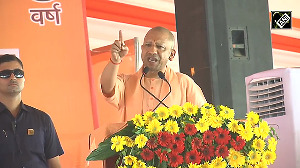Ahead of the International Fleet Review, Naval chief Admiral R K Dhowan spoke of the changing perception of the navy and the many challenges it faces on the global map. Rediff.com’s Vipin Vijayan listens in.

It’s curtains up for the International Fleet Review in Visakhapatnam. The four-day event will see more than 90 ships -- aircraft carriers, destroyers, frigates, and 70 aircraft from more than 52 countries -- participating in what is being called India’s biggest military exercise till date
Addressing delegates on the eve of the second edition of the International Fleet Review, Admiral R K Dhowan said: “No single navy is robust enough to provide safety and stability on its own. This is the responsibility of the men in white -- the navies and the coast guard -- to come up with cooperative mechanisms. That is why there is focus on networking between navies; that is why global maritime partnerships are emerging. And that is the theme of the fleet review -- that we are united by the oceans, to make the global commons safe and secure. The presence of nearly 50 countries here is an indicator that navies cooperate with each other. The maritime median lends itself into cooperation. That’s the message that every country will carry back home from here.”
When asked why the fleet review was moved to the eastern seaboard (the last time it was held in Mumbai), the naval chief explained, “The Bay of Bengal is the largest bay in the world and our neighbours -- Sri Lanka, Bangladesh, Myanmar, Thailand, Malaysia and Indonesia -- surround the Bay of Bengal.
“It was our endeavour to see that we hold the fleet review in proximity of our littoral neighbours so that it is easier for them to participate. Hence, Vizag is the city of destiny; the waters of the east coast provide us the adequate depths to hold such an event. Also, this is in tune with the aspects of the Look East and Act East policy of our government. All these aspects were taken into consideration.”

On the partnerships that India seeks to build through the fleet review, Dhowan said: “The Indian Navy has displayed its operational footprints as far east as the western Pacific, as far west as the north Atlantic, to the east coast of Africa, off the islands of the Indian Ocean region and as far as down under as Australia -- in the last one year.”
The chief further added that the Indian Navy has also held various naval exercises with other countries, such as Malabar exercise with the US, Exercise Varuna with France, Exercise Simbex with Singapore, Exercise Slinex with the Sri Lankan navy, bilateral exercises with Australia and the bilateral conference with the United Kingdom to name a few.
“We also just completed exercises with the Omani Navy off Goa and the Brazilian and South African navies will sail out of Vizag after the fleet review for Exercise INSOBAR off Goa,” he said, adding, “All these are opportunities for us to operate in various leagues of the world, enhance our interactions and also to see that the global commons are safe and secure.”
In this regard, the naval chief also pointed out that there has been a marked change in the perception of India as a maritime nation.
“We have a maritime tradition that goes back to 3300 BC. Through the Indus Valley civilization on the west coast of India, we had flourishing trade links with Mesopotamia and east coast of Africa and Egypt. On the east coast, the Kalingas, the Cholas and the Pandyas sailed to distant lands in South East Asia and established trade links. We also have a glorious ship-building tradition. The oldest warship in the world, HMS Trincomalee -- which is now restored as a museum in United Kingdom -- was built at the Bombay docks. In the last 15-20 years, there has been a revival of the importance of our maritime interests.”
“We have 12 major ports and 200 micro and intermediate ports and a large number of private ports which have come up; our island territories, trade, fishing and offshore oil -- all these are aspects of our maritime interests which have seen considerable attention by the government and are flourishing. The security umbrella of the Navy has also grown simultaneously. We have to be a multi-dimensional force. Our shipyards have risen to the occasion. Our assets today are all made in India. Today, we have a capable navy; a navy, which can take care of our maritime interest; a navy which can shape a favourable environment in the Indian Ocean region to further our maritime interests.”
Talking about the threats today’s navies have to deal with, Admiral Dhowan said that the challenges in the maritime domain are as wide and varied as they come.
“In the 21st century, navies have been grappling with pirates. The navies of the world have united against the threat and managed to control piracy. Other threats that are looming large are asymmetric warfare and terrorism. The seas are no longer the benign medium and any innocuous fishing boat can also pose a threat. So to organise the security of our ships, submarines, coast guard vessels and ships of our friends from around the world is a huge challenge. We have surveillance from the air. We have various tiers of security within and around the harbor. As we speak, all those firewalls and security tiers are in place to ensure smooth sailing.”











 © 2025
© 2025